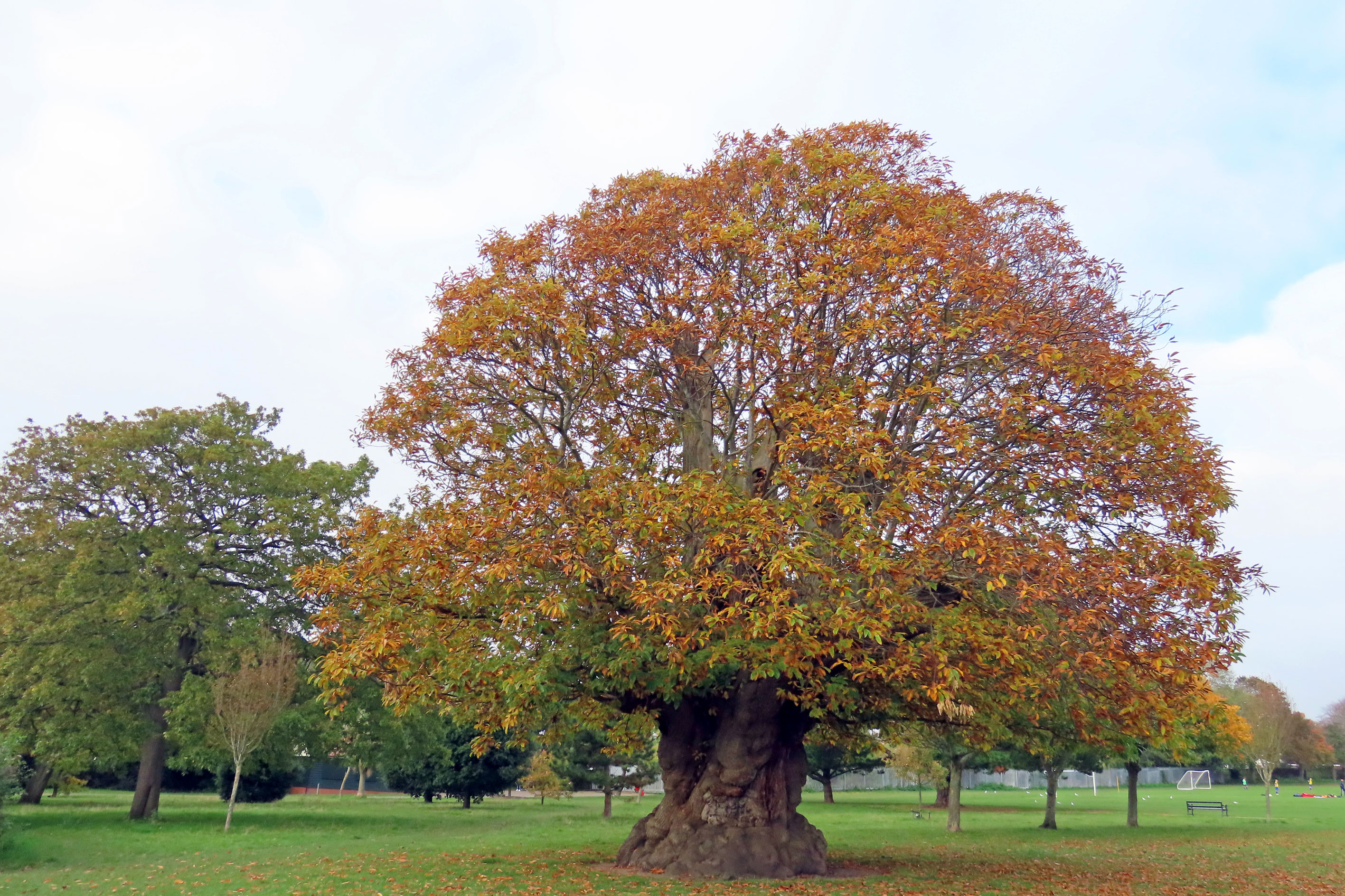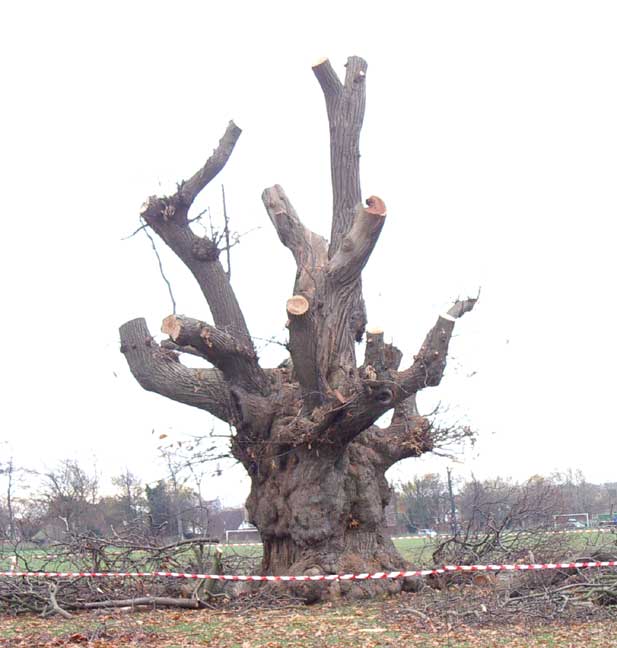Chestnut
Buckingham
Park West
Castanea
sativa
27
March 2023
Chestnut
Buckingham
Park West
3 December 2021
Bowling
Green Chestnut
from
the west
14 November 2021

Bowling
Green Chestnut
from
the south east
Bowling
Green Chestnuts
from
the south
23 February 2017
Older Tree (from the west)
Two
Chestnuts (from the south)
The
older tree is on the right and further away
The
older tree is still taller
7 July 2003
This looks like the younger tree which may only be only 60 years old? or 90 years old?
 A
Sweet
Chestnut tree in Buckingham Park was one of the most notable Chestnut
trees in the whole of Sussex. The largest was 18 metres (59 ft) high with
a girth of 222 cm (over 7 ft) in the main part of the trunk, about 1.5
metres from the ground. This is the large tree by the Bowling Green (Ref:
The Sussex Tree Book by Owen Johnson, ISBN: 0 9533493 0 6).
This tree may be over 200 years old and a topographical drawing by Samuel
Hieronymous Grimm (in the British Museum) of Buckingham House in 1782 shows
the tree as one of several in a row.
A
Sweet
Chestnut tree in Buckingham Park was one of the most notable Chestnut
trees in the whole of Sussex. The largest was 18 metres (59 ft) high with
a girth of 222 cm (over 7 ft) in the main part of the trunk, about 1.5
metres from the ground. This is the large tree by the Bowling Green (Ref:
The Sussex Tree Book by Owen Johnson, ISBN: 0 9533493 0 6).
This tree may be over 200 years old and a topographical drawing by Samuel
Hieronymous Grimm (in the British Museum) of Buckingham House in 1782 shows
the tree as one of several in a row.
It
might be younger though, but I expect it is at least 90 years old?
.
Other large Sweet Chestnuts in Sussex include one at Petworth Park at a
height of 35 metres (115 ft) and another at Cowdray
Park to 25 metres high. The Sweet Chestnut is not a native
tree to Britain and in its European and Asian range the tree often
reaches 30 metres high.
NB: According to Adur District Council, no trees in Buckingham Park have Tree Preservation Orders (TPO) allocated to them. A list of trees with TPOs does not seem to be available for Adur District.
I think that these trees should have a "Tree Inspection Record" to assess its possible dangers.
At
least one Chestnut Tree
in Buckingham Park is over 320 years old according to two different unconfirmed
sources. I have my doubts that the trees are this old.
Management
of Veteran Trees
20
October 2010
 |
 |
|
|
|
cf.
Chestnut Trees (1970s)
Shoreham
Weather 2010: Snow
 |
 |
|
|
|
3 June 2007
It is looking slightly better now.
 |
 |
The main contention was that the trees should have had TPOs on them so experts could have been consulted before the lopping.
19
December 2004
The
Chestnut
Trees on the eastern side of Buckingham Park and now being decimated.
The tallest tree of the lot has had its two largest trunks completely lopped
off.
 |
 |
 |
|
|
|
|
It is no longer the tallest in the park and this is left to the best nut cropper (left, above), the best of the trees remaining. Then the other major trunk was sawn off (picture on the far right).
12
December 2004
I
have now discovered they have hacked away at the other younger Chestnut
Tree near the Bowling Green at Buckingham Park, Shoreham, that formed
the pair, and made another unsightly job of it. This tree was not damaged
in the summer gales.
 |
 |
|
|
|
7 December
2004
The
most attractive of the four two century old large Chestnut Trees
in Buckingham Park has now been butchered. It had received damage after
the gales in July 2004, but it has now been destroyed as an important landmark
and this was the most notable tree in the whole of the Adur district. The
foreman of the tree fellers said that the work had been done on safety
grounds after a public complaint and on advice to chop away the rotten
bits (hearsay).
 |
 |
|
|
|
10
August 2004
This
would be one of the last photographs of the younger of the two Chestnut
Trees on the western side.
 21
July 2004
21
July 2004
This
is the first time I have noticed that the two centuries old specimen Sweet
Chestnut Tree in Buckingham Park has suffered
damage in the recent gales and one branch seems to have broken off. I probably
have not passed that way since the gales and I could not see any signs
of the fallen major branch.
 |
The date of this photograph
is unknown.
It is probably in the 1970s. |
Trees at the eastern end:
 |
 |
That Old Chestnut in the Park
Residents and visitors were dismayed at the major surgery performed on the best loved tree in Shoreham in the autumn of 2004. The Bowling Green Sweet Chestnut Tree in Buckingham Park was the oldest of a pair and had stood proudly in the centre of Buckingham Park where a Chestnut Tree had stood proudly for the last two or three centuries. The Sussex Tree Book by Owen Johnson includes this tree as number three of the finest Chestnut Trees in Sussex before the lopping and only exceeded in girth by two others in the county. It was particularly important to me as I included it as the most important tree in Shoreham in my nature slide show presentation.
Was it the same tree that featured in a topographical drawing by Samuel Hieronymous Grimm (in the British Museum) of Buckingham House in 1782 showing the tree as one of several in a row? It was in the same place and one expert had estimated that the old tree with a height of 18 metres (59 ft) and with a girth (shoud this be diameter?) of 222 cm (over 7 ft in the main part of the trunk, about 1.5 metres from the ground) was 265 years old, which meant it was planted in 1740. My estimate is that the tree was planted between 1657 and 1840 and could be anything between 165 and 348 years old. My best guess is that the tree was replaced in the nineteenth century.
It had certainly remained the same since I remember it in the 1960s. During that time it had received minor lopping but nothing so drastic as last year. Adur District Council maintain that the work was necessary on health and safety grounds. One major branch had broken off in the gales in July 2004, but the proud tree had stood firm and intact against the Great Storm of October 2000 which had decimated half of the trees in Buckingham Park.
Its partner was a much younger tree and was a standard showing no sign of the coppicing of the 19th century, so I think this was a relatively young tree that had not finished growing and this tree had doubled in size since the 1970s. This one was not damaged in the gales so the work seemed unnecessary to the passer-by.
Chestnut trees on the same latitude on the eastern side of Buckingham Park were also badly lopped, but these large trees were not so attractive to the eye. One remains largely intact and this provides a good crop of chestnuts every year.
Chestnut Trees are not native to England. Popular books claim they were introduced by the Romans and there is evidence that the Romans used Chestnut wood in England. Some dendrochronologists claim that the Chestnut would most likely have introduced even earlier, and some claim that it did not become an established part of the British arboreal flora until late medieval times. I think on the balance of probability that the Romans introduced the tree, but it did not become popular and a self generating species on a large scale until the nineteenth century when its wood was valued for fencing.
The
Sweet Chestnut grows on clay and alluvial soils but it is not found on
the chalk downs. Trees are natural architecture and I have asked Adur District
Council for a list of trees with Tree Preservation Orders on in the Adur
District.